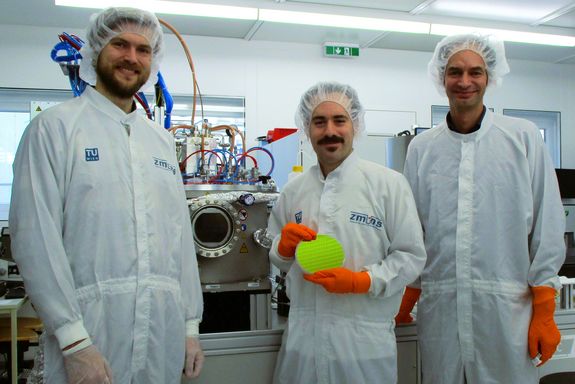Even the most complicated data processing on a computer can be broken down into small, simple logical steps: You can add individual bits together, you can reverse logical states, you can use combinations such as "AND" or "OR". Such operations are realized on the computer by very specific sets of transistors. These sets then form larger circuit blocks that carry out more complex data manipulations.
In the future, however, the design of electronic circuits could look completely different: For years, people have been thinking about the possibilities offered by electronic circuits that do not perform a physically fixed task, but can be switched flexibly depending on the task at hand – a new kind of reprogramming that does not take place at the software level, but at the fundamental hardware level: directly on the transistors, the nanoscale building blocks of electronic circuits.
This is exactly what a research team at TU Wien has now achieved: they have developed intelligent, controllable transistors and combined them into circuits that can be reliably and quickly switched back and forth between different tasks. This means that the same functionality as before can be accommodated on less chip space. This does not only save manufacturing costs, but also energy, and it enables higher computing speeds.
A completely new transistor concept
"In microelectronics, we normally work with semiconductors that are deliberately contaminated," explains Prof. Walter M. Weber from the Institute of Solid State Electronics at TU Wien. "Such a material would be silicon, for example, in which certain foreign atoms are incorporated. This is known as doping."
These foreign atoms either have one electron more than the atoms around them, in this case the additional electron can move within the material relatively easily. Or they have one electron less and electrons from their surroundings can move in, in this case the electron is missing elsewhere - in this case, instead of the electron, a so-called "hole" moves through the material: a place where an electron is missing.
Both - charge transport by moving electrons and charge transport by moving holes - play an important role in microelectronics. The doping determines where and in which direction current can flow and where it cannot. This means that the function of conventional transistors is fixed during manufacture and can no longer be changed. The current flow through the transistor is then switched "on" or "off" using a control electrode.
But there is another way: the transistors that have been developed at TU Wien in recent years no longer contain any doped material at all. Instead, the behavior of the charge carriers in the material is controlled by electric fields: electric charge is introduced into the transistor via an additional electrode, which determines how the transistor should behave. This is known as "electrostatic doping". It replaces the technically very complex and expensive process of doping with foreign atoms.
"Unlike in conventional semiconductor technology, the logical operation of a particular circuit is not determined from the outset. We can reconfigure the function of a circuit according to our requirements," explains Dr. Masiar Sistani (also Institute of Solid State Electronics, TU Wien). "For example, you can make an addition circuit out of two very compact XOR links using our technology. With conventional technology, you would have to produce two different circuits for these tasks and therefore take up a lot more chip area; with our technology, one can do both."
In order to achieve maximum flexibility, components had to be developed that can be operated either by transporting electrons or by transporting holes, as required, and at the same switching properties - a major challenge that was overcome at TU Wien.
This means that more functionality can be accommodated on the same surface area - and this is the decisive parameter for the chip industry. "In today's chips, you have different blocks that can perform very specific tasks," explains DI Lukas Wind (PhD student at the Institute of Solid State Electronics, TU Wien). "You have to constantly send information from one block to another. That takes time and costs energy." With the new, more flexible technology, the same information could be processed efficiently and in a resource-saving manner in one place.
Not just transistors, but functional circuits
The team presented the first intelligent, configurable transistors back in 2021. Now, however, the decisive step has been taken: they were able to show that all basic logic circuits can actually be assembled from them - and that they can be converted into other circuits by reconfiguring the components.
The research group is already cooperating with companies from the chip industry. "There is a lot of interest," says Prof. Walter Weber. "Of course, this is a significant step that cannot be implemented from one day to the next. But our approach does not require any new materials or processes; we use silicon and germanium, materials that are also used today."
For decades, progress in microelectronics was primarily based on the miniaturization of individual components. Recently, however, natural limits have been reached - at the latest when you get down to the atomic scale, further miniaturization is no longer possible. This is precisely why intelligent, reconfigurable components could be an exciting option for intelligent, self-learning or even neural computer systems that can adapt their function to the requirement profile in order to perform calculations as quickly and energy-efficiently as possible.
Original publication
Contact
Dr. Masiar Sistani
Institute for Solid State Electronics
TU Wien
+43 1 58801 36213
masiar.sistani@tuwien.ac.at
Univ.Prof. Dr.-Ing. Walter M. Weber
Institute for Solid State Electronics
TU Wien
+43 1 58801 36240
walter.weber@tuwien.ac.at

![[Translate to English:] Schematische Darstellung des Tranistors](/fileadmin/_processed_/b/0/csm_Rekonfigurierbare_Elektronik_V4_high_res_de069cf2d5.png)